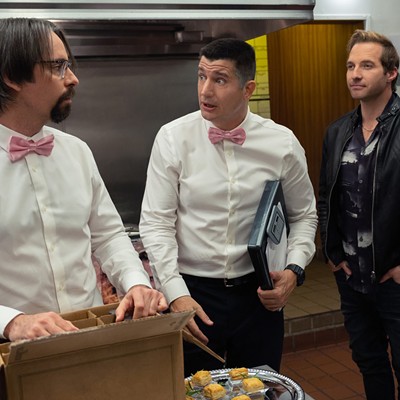Friday, May 17, 2013
Torture scenes on TV are worse than icky — they're boring
I’ve been regularly watching TV for less than decade.
But in that time, I’ve seen fingers broken, kneecaps shot, a hand shot, an earlobe sliced with a knife, a cheek held against a red-hot oven element, needles driven up finger tips, bamboo driven under fingernails, skin shocked with a lamp cord and covered in corrosive chemicals, veins injected with painful drugs, heads shoved under water and in a barrel of motor oil.
I’ve seen a man tased repeatedly until his heart stops. I’ve seen a woman dunked in a bathtub with electrical equipment. I’ve seen people beaten with fists, whips, chains and a phonebook.
A hardening resin is poured down one man’s throat on one show, while on another the hero takes a wet towel and threatens to shove it down someone’s esophagus to rip out of his stomach lining. I’ve seen a single scene were an unarmed man was beaten, choked, twisted with a plier, slashed with a knife and burned with a blowtorch. (That’s by a “good guy.”) I’ve seen people subjected to belt sanders, defibrillation paddles and sensory deprivation chambers. I’ve seen a whole lot of waterboarding.
I’ve a barrel heated up so the rats inside dig through the chest cavity, I’ve seen a finger being meticulously skinned. In the last week alone, I’ve seen a gleeful woman spattered with blood as she drills into a man's thigh, and – if the scene hadn’t cut away at the last moment (for, you know, decency) would have nearly seen a castration.
That’s just a selection from a few TV shows — Lost, 24, Game of Thrones, Alias, Prison Break, Scandal and the Shield. I’ve never watched The Sopranos or Homeland — both shows which, presumably, feature a quite a bit of torture. (I’m also only four episodes into Downton Abbey, so if the Dowager Countess ends up using sharper implements than her wit to protect the estate, I haven’t yet seen it.)
As the United States debated the ethics and effectiveness of torture (or “enhanced interrogation,” if your kids are around) over the past decade, it’s been a crucial debate. So it’s unsurprising out television shows have chosen to draw from that debate, and it’s unsurprising that activists have condemned (or praised) the cavalier way that TV gets its torture on.
But today, I’m not going to retread the ground of what torture does to our country, or our national security, or our soul.
Today, I’m upset about what it’s done to our television shows.
I can choose not to see Saw or Hostel, but if a torture scene is the part of a larger narrative I’ve invested a 100 hours in, they’re harder to avoid. They can be violent, they’re stomach turning, they’re genuinely gross.
And worse, with very rare exceptions, these moments of torture are the weakest on the show.
I think of graphic violence the same way I think of a dirty joke told in mixed company — the dirtier it is, the funnier it has to be to justify. In the case of stomach-rending (sometimes literally) violence it should be extremely compelling, illuminating, or tense — it should drive the plot forward, or reveal interesting aspects of depths of character.
But torture rarely does. Instead, torture scenes are usually dramatically inert.
Consider how, in a perfectly symbolic way, most of them have the poor tortured soul literally tied to a chair. He’s not going anyway. Often, that’s the purpose the scene serves in the narrative: To stall the story, to kill time.
On 24 — a show often trapped by its real-time format — a torture scene gave a character something to do for an episode, without necessarily bringing Jack Bauer closer to the bomb/virus/weapon/season finale. On Game of Thrones, repeated torture scenes kept Theon employed as a regular cast member until he could appear up in the later seasons based on later books.
Hence the formula: The threatening monologue from the torturer, the reveal of torture implements, pleading or defiance from the victim, a whirring or a blade or a crackle of electricity or a swing of a fist, a bloodcurling scream —cut to commercial.
Occasionally the writers like to show off their sadistic creativity — here’s my awesome idea for inflicting pain upon the human body. But believe me, I’ve walked through a Torture in the Middle Ages exhibit in a museum in Russia — modern TV writers can’t hope to match history. It’s been done.
Sometimes, of course, torture is supposed to act as a critique against it. It’s supposed to show the tough choices of the War on Terror or the War Against The Criminal Element. It’s supposed to show the degradation it inflicts, not just upon the tortured, but the torturer.
But this rarely happens.
Most of the time, torture is practically shrugged off as a bad-boy quirk, like wearing leather jackets or drinking from a flask or using the B-word. “Oh, you!” The show says, “Did you cut off the victim’s toes again, you silly goose!”
On 24, Jack Bauer’s a loose cannon, but dammit Chief, he gets results. On Scandal, Huck has clearly been mentally altered by torturing and being tortured — but his colleagues basically continue to treat him like a big ol’ teddy bear with a lingering waterboarding habit instead of an actual monster. (The Shield was a thankful exception — its greatest feat was showing how truly poisonous Vic Mackey was to everyone around him.)
Other times, torture feels like sadism for sadism's sake, the succession of the weekly “And now, back to your regularly scheduled Theon Greyjoy mutilation session!” torture scenes on Game of Thrones so far only tell us two things: 1) This guy’s pretty evil. 2) Sucks to be Theon.
Game of Thrones already had (at least!) two psychopaths before the latest torturer was introduced. So far, this new guy doesn’t add much.
But here’s the biggest problem: It’s not hard to make someone feel pain. Anyone who’s ever slammed their fingers in a car door knows that great amounts of agony can be inflicted extremely easily. When the Manly Man just grits away all the pain, it doesn’t seem realistic, and when the torturer gives up a secret location of a bomb, it doesn’t feel earned. (Absurdly, the torture victim rarely ever lies which is my go-to plan if I’m ever tortured.)
It’s absurd to treat torture like a Vulcan Mind-Meld, something that if you do it just right will automatically get the truth.
Great drama works by playing different powers against each other. Whether we’re talking the kings of Game of Thrones or the hicks of Justified, factions play their hands, and other factions counter. They may rely on wit or alliances or a quick draw or massive armies or jury-rigged weapons or a box full of rattlesnakes — but there’s almost always a way to counter. A brute threatens a dwarf? The dwarf uses his clever words and his family reputation to talk his way out. A rich man threatens to use the law to crush a poor man? The poor man breaks into the rich man’s home and threatens to kills his family.
Dutch talking a confession out of a suspect on The Shield was always so much more interesting than Mackey beating him out of it.
When a man’s tied to a chair being burned or cut or shocked, there’s rarely an interesting interplay — there’s too much power imbalance. Instead, they just scream, and we grimace and yawn.
Tags: Television , TV , Video



















